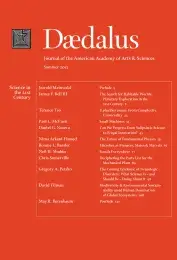Microbes as Menaces, Mates & Marvels
The conventional understanding of microbes as causative agents of disease has led us to fear them and to consider them our deadly enemies. Much less appreciated are the central roles microbes play in shaping the environment and in maintaining plant, animal, and human health. All metazoan organisms – organisms that we can see with the naked eye – exist in lifelong partnerships with vast microbial communities. These “microbiomes” supply metazoans with essential life processes that are not encoded in nonmicrobial genomes. Recent work in microbiology has revealed that microbes, like metazoans, have specific body plans and sensory systems, that they can communicate with each other, and that they orchestrate collective behaviors. Investigations of these ancient yet enduring processes are uncovering the fundamental design principles of life. Microbes are also storehouses of new molecules, biochemical pathways, and materials with medical, industrial, and agricultural relevance. Scientists are harnessing these microbial products in efforts to confront humanity’s most pressing problems. This essay explores the wonder, complexity, power, and utility of microbes in the twenty-first century.
You may think you’ve seen everything, but in fact, most of the world is invisible to us. It is composed of, and was constructed by, microbial organisms. Microbes are single-celled organisms too small to see with the naked eye. They include archaea, fungi, and protists, but overwhelmingly, they are bacteria. For billions of years these invisible critters, our forefathers, have been shaping the Earth and making it a suitable place for us to live. Higher organisms–all plants, invertebrates (including insects), and vertebrates (including humans)–occupy only a sliver of the world. We live exclusively within narrow ranges of temperature, air pressure, atmosphere, pH, and nutrient sources. Microbes, by contrast, have adapted to, inhabited, exploited, and tamed every niche on Earth. They thrive under extreme pressure and at high temperatures miles below the ocean surface, enveloped in the sulfurous smoke spewing from thermal vents. They live encrusted in the sediments of lakes beneath ice caps that have not thawed in more than ten thousand years. There, they exist in a world that has not seen the light of day or taken a breath from the atmosphere for millennia. Microbes flourish at the pH of battery acid, and in this hostile environment, they produce the stunning, gemstone-colored pools found in Yellowstone National Park. Unlike the human diet, which is narrow and invariant, microbes consume, well, everything. They eat the regular stuff–proteins and carbohydrates–but also radioactivity, rocks, crude oil, rust, paint, dirt, and wood. Every plant, animal, and human requires a vast community of commensal microbes working 24/7 to keep it alive and healthy.
As the foundation of nineteenth- and twentieth-century biological science, microbes enabled scientists to dismiss the possibility of spontaneous generation. They inspired Robert Koch’s postulates, revealing disease causation for the first time. Microbes gave scientists a way to deduce the famous DNA double helix; they showed that heritable information is encoded in units of genes and that the essential parts of life are DNA, RNA, proteins, and lipids. Ironically, these paradigm-changing discoveries also made the microbial sciences passé. By the mid-twentieth century, microbes were generally thought to have been picked clean. Science instead focused on more “complex” problems: namely, embryonic development, neurocircuitry, and cancer.
. . .
